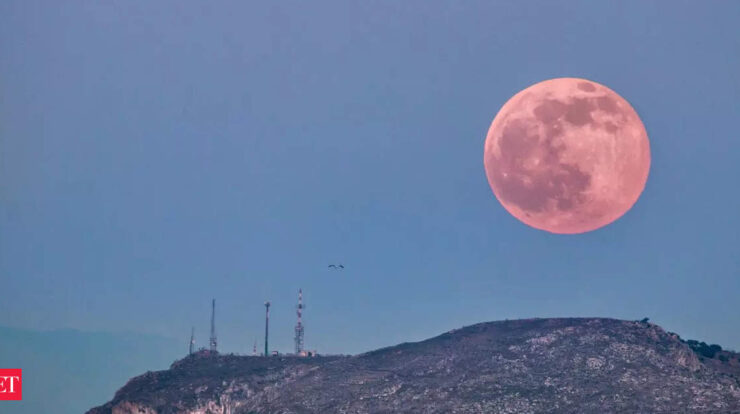
The Pink Moon 2024, a celestial event steeped in cultural and natural significance, is poised to grace the night sky. This captivating lunar phase holds profound implications for astronomy, culture, wildlife, and art, offering a unique opportunity for reflection and awe.
From its astronomical origins to its symbolic representation of hope and renewal, the Pink Moon 2024 promises to be an unforgettable spectacle.
The Astronomical Significance of the Pink Moon 2024
The Pink Moon of 2024, scheduled to occur on April 24th, holds astronomical significance due to its unique celestial characteristics. This full moon derives its name from the pinkish hue it often displays when rising above the horizon, a result of atmospheric scattering of sunlight during springtime.
The Pink Moon marks the beginning of spring in the Northern Hemisphere, signaling the transition from winter’s slumber to the awakening of nature.
Astrological Implications
In astrology, the Pink Moon is associated with the sign of Scorpio, known for its transformative and intense energy. This lunar phase is believed to amplify emotions and encourage self-reflection, providing an opportunity for individuals to delve deep into their inner selves and confront their hidden desires and fears.
The Cultural and Historical Importance of the Pink Moon
Cultural Significance
The Pink Moon has held cultural significance in various societies throughout history. In Native American traditions, the Pink Moon is known as the “Planting Moon,” as it signifies the optimal time to sow seeds and prepare for the growing season.
In Celtic cultures, the Pink Moon was associated with the goddess Ostara, symbolizing fertility and new beginnings.
Historical Events
Historically, the Pink Moon has been associated with notable events. For instance, the Pink Moon of 1775 marked the Battle of Lexington and Concord, a pivotal moment in the American Revolutionary War. The Pink Moon of 1969 coincided with the Apollo 11 mission, which resulted in the historic first moon landing.
The Pink Moon’s Impact on Nature and Wildlife
Effects on Tides and Currents
The Pink Moon’s gravitational pull influences the tides, leading to higher high tides and lower low tides during this lunar phase. This effect is particularly noticeable in coastal areas, where the Pink Moon’s gravitational influence can cause increased tidal surges.
Behavioral Changes in Animals
The Pink Moon’s bright illumination affects the behavior of certain wildlife species. Nocturnal animals, such as owls and foxes, may exhibit increased activity during this lunar phase, while diurnal animals, such as deer and rabbits, may be more cautious.
The Pink Moon in Art and Literature

Artistic Inspiration
The Pink Moon’s ethereal beauty has inspired numerous works of art throughout history. Painters like Claude Monet and Vincent van Gogh captured the moon’s delicate hues and soft glow in their masterpieces. Sculptors have also found inspiration in the Pink Moon, creating sculptures that evoke its celestial presence.
Literary Symbolism
In literature, the Pink Moon often serves as a symbol of hope, renewal, and transformation. Writers like William Shakespeare and Emily Dickinson have used the Pink Moon as a literary device to convey themes of love, loss, and the passage of time.
Observing and Capturing the Pink Moon
Observing the Pink Moon
To observe the Pink Moon with the naked eye, find an open area with clear skies. The Pink Moon is typically visible shortly after sunset, rising in the east and reaching its peak in the southern sky. Binoculars or a telescope can enhance the viewing experience, allowing for closer observation of the moon’s craters and surface features.
Capturing the Pink Moon, Pink moon 2024
Photographers can capture stunning images of the Pink Moon using a variety of techniques. A tripod is essential for stability, and a telephoto lens will allow for close-up shots of the moon’s surface. Long exposure times can capture the moon’s movement across the sky, creating dramatic star trails.
The Pink Moon as a Symbol of Hope and Renewal
The Pink Moon has long been associated with hope and renewal, marking the transition from winter’s darkness into the vibrant colors of spring. It is a time for reflection and introspection, as individuals embrace the opportunity to shed old habits and embrace new beginnings.
The Pink Moon’s symbolism extends to communities, representing unity, growth, and the promise of a brighter future.
Epilogue
As the Pink Moon 2024 ascends, it serves as a reminder of the interconnectedness between celestial phenomena, cultural traditions, and the natural world. By embracing its multifaceted significance, we can deepen our appreciation for the wonders of the universe and our place within it.
Expert Answers
What is the astronomical significance of the Pink Moon?
The Pink Moon derives its name from the presence of wildflowers known as wild ground phlox, which bloom in abundance during this time of year.
How does the Pink Moon impact wildlife?
The Pink Moon’s gravitational pull influences ocean tides and animal behavior. Many species exhibit increased activity and heightened senses during this lunar phase.
What is the symbolic meaning of the Pink Moon?
The Pink Moon represents new beginnings, growth, and emotional healing. It is associated with hope, optimism, and the promise of renewal.





